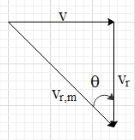
Answer
409.8k+ views
Hint: Read the given information and draw a vector diagram for the situation to get a better and easy understanding. Then by using trigonometric identities and some geometry calculate the value of $\tan \theta $.
Formula used:
${{\sin }^{2}}\theta +{{\cos }^{2}}\theta =1$
Complete step by step answer:
Let the man be walking on the road with a velocity v. It is given that the rain is falling down vertically. Since the man is moving, the direction of the coming rain will be different with respect to the man. Let the velocity of the rain be ${{v}_{r}}$ in the downward direction.
And let the man move in the direction of the positive x-axis. It is also given that the man has to hold his umbrella at an angle $\theta $ to vertical. This means that the direction of the rain, for the man, is making an angle $\theta $ with the vertical, as shown in the figure.

It is said that the speed of the rain with respect to the man is 1.5 times his speed. Then this means that the speed of the rain with respect to the man is equal to ${{v}_{r,m}}=1.5v$
Now, from the figure we get that $\sin \theta =\dfrac{v}{1.5v}=\dfrac{2}{3}$.
Let use the identity ${{\sin }^{2}}\theta +{{\cos }^{2}}\theta =1$
$\Rightarrow {{\left( \dfrac{2}{3} \right)}^{2}}+{{\cos }^{2}}\theta =1$
$\Rightarrow {{\cos }^{2}}\theta =1-\dfrac{4}{9}=\dfrac{5}{9}$
$\Rightarrow \cos \theta =\dfrac{\sqrt{5}}{3}$, (we shall only consider the positive value since our angle is acute)
Now, we know that $\tan \theta =\dfrac{\sin \theta }{\cos \theta }$.
Then,
$\therefore \tan \theta =\dfrac{\dfrac{2}{3}}{\dfrac{\sqrt{5}}{3}}=\dfrac{2}{\sqrt{5}}$
Hence, the correct option is A.
Note:We can also directly calculate the value of $\tan \theta $ by first find the value of ${{v}_{r}}$ in terms of v with the help of Pythagoras theorem.
From Pythagoras theorem we get that $v_{r,m}^{2}=v_{r}^{2}+{{v}^{2}}$.
Substitute ${{v}_{r,m}}=1.5v$.
Then,
$\Rightarrow {{(1.5v)}^{2}}=v_{r}^{2}+{{v}^{2}}$`
$\Rightarrow v_{r}^{2}=\dfrac{9}{4}{{v}^{2}}-{{v}^{2}}=\dfrac{5}{4}{{v}^{2}}$
$\Rightarrow {{v}_{r}}=\dfrac{\sqrt{5}}{2}v$.
Then,
$\therefore\tan \theta =\dfrac{v}{{{v}_{r}}}=\dfrac{v}{\dfrac{\sqrt{5}}{2}v}=\dfrac{2}{\sqrt{5}}$
Formula used:
${{\sin }^{2}}\theta +{{\cos }^{2}}\theta =1$
Complete step by step answer:
Let the man be walking on the road with a velocity v. It is given that the rain is falling down vertically. Since the man is moving, the direction of the coming rain will be different with respect to the man. Let the velocity of the rain be ${{v}_{r}}$ in the downward direction.
And let the man move in the direction of the positive x-axis. It is also given that the man has to hold his umbrella at an angle $\theta $ to vertical. This means that the direction of the rain, for the man, is making an angle $\theta $ with the vertical, as shown in the figure.

It is said that the speed of the rain with respect to the man is 1.5 times his speed. Then this means that the speed of the rain with respect to the man is equal to ${{v}_{r,m}}=1.5v$
Now, from the figure we get that $\sin \theta =\dfrac{v}{1.5v}=\dfrac{2}{3}$.
Let use the identity ${{\sin }^{2}}\theta +{{\cos }^{2}}\theta =1$
$\Rightarrow {{\left( \dfrac{2}{3} \right)}^{2}}+{{\cos }^{2}}\theta =1$
$\Rightarrow {{\cos }^{2}}\theta =1-\dfrac{4}{9}=\dfrac{5}{9}$
$\Rightarrow \cos \theta =\dfrac{\sqrt{5}}{3}$, (we shall only consider the positive value since our angle is acute)
Now, we know that $\tan \theta =\dfrac{\sin \theta }{\cos \theta }$.
Then,
$\therefore \tan \theta =\dfrac{\dfrac{2}{3}}{\dfrac{\sqrt{5}}{3}}=\dfrac{2}{\sqrt{5}}$
Hence, the correct option is A.
Note:We can also directly calculate the value of $\tan \theta $ by first find the value of ${{v}_{r}}$ in terms of v with the help of Pythagoras theorem.
From Pythagoras theorem we get that $v_{r,m}^{2}=v_{r}^{2}+{{v}^{2}}$.
Substitute ${{v}_{r,m}}=1.5v$.
Then,
$\Rightarrow {{(1.5v)}^{2}}=v_{r}^{2}+{{v}^{2}}$`
$\Rightarrow v_{r}^{2}=\dfrac{9}{4}{{v}^{2}}-{{v}^{2}}=\dfrac{5}{4}{{v}^{2}}$
$\Rightarrow {{v}_{r}}=\dfrac{\sqrt{5}}{2}v$.
Then,
$\therefore\tan \theta =\dfrac{v}{{{v}_{r}}}=\dfrac{v}{\dfrac{\sqrt{5}}{2}v}=\dfrac{2}{\sqrt{5}}$
Recently Updated Pages
How many sigma and pi bonds are present in HCequiv class 11 chemistry CBSE

Mark and label the given geoinformation on the outline class 11 social science CBSE

When people say No pun intended what does that mea class 8 english CBSE

Name the states which share their boundary with Indias class 9 social science CBSE

Give an account of the Northern Plains of India class 9 social science CBSE

Change the following sentences into negative and interrogative class 10 english CBSE

Trending doubts
Difference between Prokaryotic cell and Eukaryotic class 11 biology CBSE

Which are the Top 10 Largest Countries of the World?

Differentiate between homogeneous and heterogeneous class 12 chemistry CBSE

Fill the blanks with the suitable prepositions 1 The class 9 english CBSE

Difference Between Plant Cell and Animal Cell

Give 10 examples for herbs , shrubs , climbers , creepers

The Equation xxx + 2 is Satisfied when x is Equal to Class 10 Maths

Write a letter to the principal requesting him to grant class 10 english CBSE

Change the following sentences into negative and interrogative class 10 english CBSE



